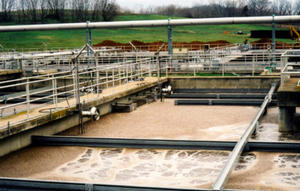The water we drinkWastewater treatment lowers pathogen levels
New analysis shows that pathogens levels in municipal water have dropped since the implementation of federal regulations on treating sewage in 1993; these treatment guidelines have proven to be extremely effective with 94 percent to 99 percent of all pathogens in biosolids eliminated after wastewater treatment

Removing up to 99% of biosolid pathogens // Source: pennlive.com
A recent study by a team of researchers at the University of Arizona has tracked the incident of pathogens in biosolids over a nineteen year period in one major U.S. city. In the same study, the researchers also analyzed pathogen levels in biosolids at eighteen wastewater treatment plants in the United States.
Their analysis indicates pathogens levels have dropped since the implementation of federal regulations on treating sewage in 1993. These treatment guidelines have proven to be extremely effective with 94 percent to 99 percent of all pathogens in biosolids eliminated after wastewater treatment.
“This is the first major study of its kind since federal regulations for wastewater treatment were implemented in 1993,” says Dr. Ian Pepper, one of the authors of the study and the director of the University of Arizona’s Environmental Research Laboratory.
The term biosolid refers to sewage sludge that has under gone a certain level of treatment and is divided into two classifications. Class A biosolids undergo a high level treatment and do not show any signs of pathogens. In contrast, Class B biosolids receive a lower amount of treatment and have been found to contain bacterial, parasitic, and viral pathogens.
Around 5.5 billion kilograms of biosolids are produced annually in the United States, with the vast majority being Class B. Approximately 60 percent of the annual production of biosolds is used as agricultural fertilizer.
Pepper adds, “By analyzing the data before and after 1993, the Arizona group was able to determine the influence of the regulations on the incidence ofpathogens in Class B biosolids. The study showed that fecal coliforms and virus concentrations are now generally lower than before the 1993 regulations.”
Class B biosolids from the Pima County Ina Road Wastewater Treatment Plant in Tucson were analyzed from 1988 to 2006. Additional samples were collected between 2005 and 2008 from wastewater treatment plants in California, Florida, Arizona, Michigan, Minnesota, Wisconsin, Nevada,Oregon, Washington and Wyoming. ALL the samples were analyzed at the University of Arizona.
— Read more in Huruy Zerzghi et al., “Long-Term Effects of Land Application of Class B Biosolids on the Soil Microbial Populations, Pathogens, and Activity,” Journal of Environmental Quality 39, no. 1 (January 2010): 402-8 (doi: 10.2134/jeq2009.0307)
